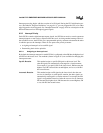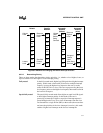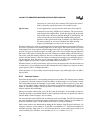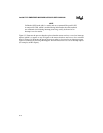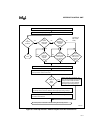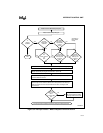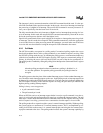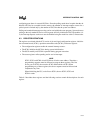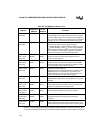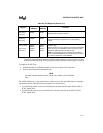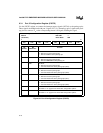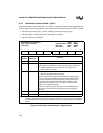
Intel386™ EX EMBEDDED MICROPROCESSOR USER’S MANUAL
9-14
The interrupt’s priority structure determines which EOI command should be used. Use the spe-
cific EOI command for the special mask mode. In this mode, a lower-level interrupt can interrupt
the processing of a higher-level interrupt. The specific EOI command is necessary because it al-
lows you to specifically clear the lower level in-service bit.
The fully nested mode allows only interrupts of higher levels to interrupt the processing of a low-
er-level interrupt. In this mode, the nonspecific EOI command automatically clears the in-service
bit for the current process (because it has the highest level).
Special-fully nested mode allows equal or higher level requests to interrupt the processing of oth-
er interrupts. For this mode, the nonspecific EOI command automatically clears the appropriate
in-service bit. However, when processing master IR2 interrupts, you must make sure all the slave
in-service bits are cleared before issuing the nonspecific EOI command to the master.
9.2.5 Poll Mode
The 82C59A modules can operate in a polling mode. Conventional polling requires the core to
check each peripheral device in the system periodically to see whether it requires servicing. With
the 82C59A’s polling mode, the core, by initiating the polling process, can determine whether any
of the devices attached to the 82C59A require servicing. This improves conventional polling ef-
ficiency by allowing the core to poll only the 82C59A, not each of the devices connected to it.
The polling mode is enabled by setting the polling bit in the Operation Command Word 3 register
(OCW3).
NOTE
After the polling procedure has been executed once, polling is disabled, i.e., it
is a one-shot operation. To repeat the polling procedure, the polling bit must be
set again.
The polling process takes the place of the standard interrupt process. In the standard interrupt pro-
cess, the master sends interrupt requests to the core. In the polling mode, an interrupt request can
be detected by reading the 82C59A’s poll status byte. The poll status byte indicates whether the
82C59A requires servicing. If the 82C59A requires servicing, the poll status byte indicates the
highest-priority pending interrupt request.
Polling is always a two-step process:
• A poll command is issued.
• The poll status byte is read.
When an 82C59A receives an interrupt request before it receives a poll command, it sets the re-
quest’s in-service bit and configures the poll status byte to reflect the interrupt request. The poll
status byte is used to determine which device connected to the 82C59A requires servicing. At the
end of a request’s servicing, you must issue a command to clear the request’s in-service bit.
The polling mode allows expansion of the system’s external interrupt capability. Without polling,
the system can have a maximum of 52 external interrupt sources. This is accomplished by cas-
cading six 82C59As to the master’s six external interrupt pins and using the four external inter-
rupt pins connected to the slave. The polling mode increases the system’s interrupt capability by



